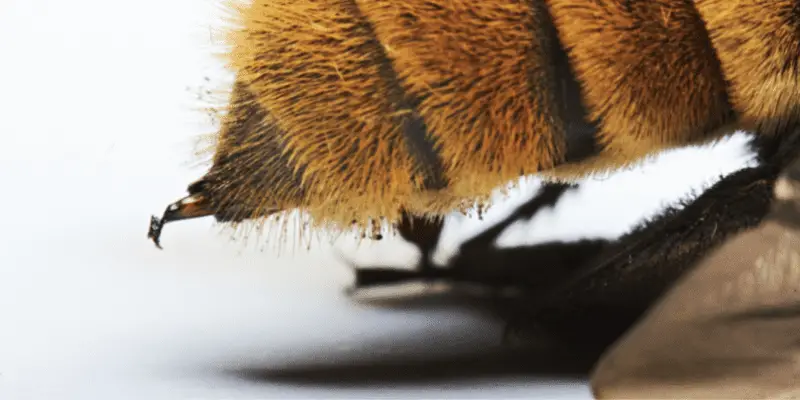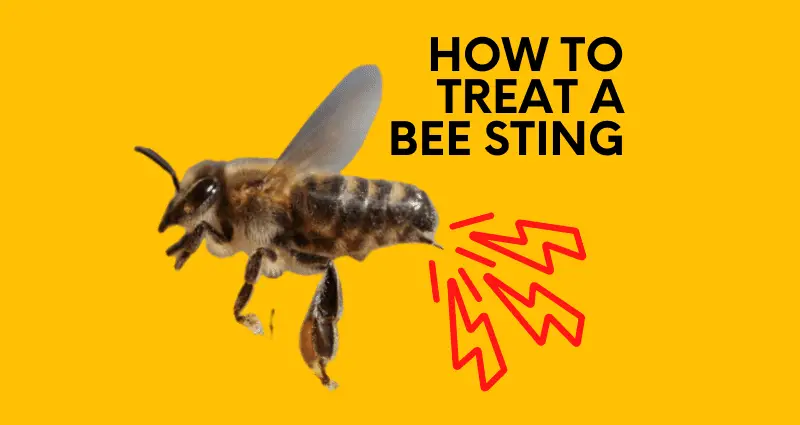Quickly remove the stinger by scraping over the top with a fingernail or gauze. Do not squeeze the stinger, as it will release more venom into the skin. Wash the sting location with soap and water and then apply a cold compress to reduce the pain and swelling. If swelling and pain continue, go the the emergency room immediately.
5% of the world’s population will be stung by a bee in a given year.
A single sting can be painful and may not trigger any severe symptoms. But, if you’re allergic to bee venom, the sting could develop into a life-threatening illness.
So, regardless of whether you’re allergic, it’s essential to know what to do and what not to do in situations like these.
This post will dive into bee sting symptoms, complications, treatments, home remedies, and advice on when to see a doctor.
Let’s get started.
Symptoms of A Bee Sting
Honey bees, hornets, yellow jackets, and wasps are the most common stingers you might encounter. The stings contain venom, inducing a local toxic reaction in the injured area.
If you get stung by a bee or other insect, you’ll know by the pain. But in the case of multiple stings, knowing the signs of a sting will help you treat the affected areas more effectively.
The typical local reactions include;
- Sudden intense pain at the site of the attack
- Redness or itchiness around the affected areas
- Swollen hives or welts peaking around after 48 hours and lasting up to an entire week
Some stings can cause different symptoms, including but not limited to:
- Redness and swelling can grow up to 12 inches
- Swelling of the entire limb
- Fever, nausea, and headache stemming from multiple bee or wasp stings
- Pain and swelling in joints days after the incident
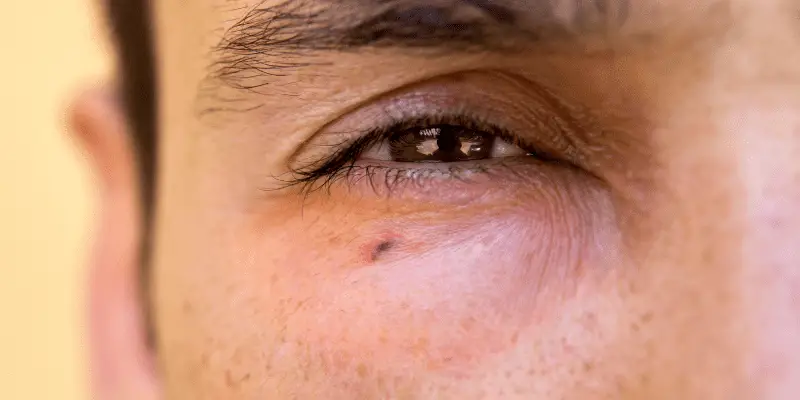
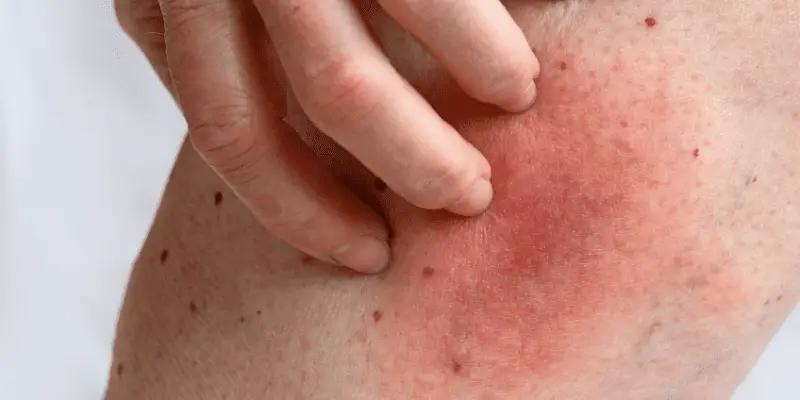
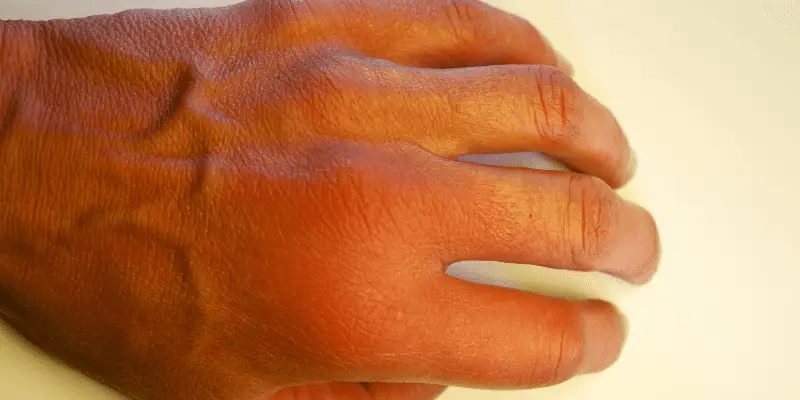
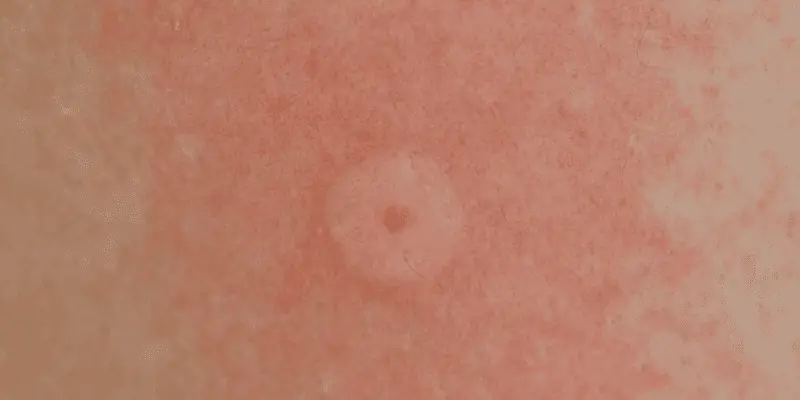
How painful is a bee sting?
The Schmidt sting pain index, which rates pain caused by insect stings on a 1-4 scale, suggests that most bee stings register at one or two. Certain wasps and ants produce 3-level pain, while bites by a tarantula and specific wasp and ant species can result in the highest level.
However, the pain level depends on an individual’s pain tolerance and where they were stung. According to research done at Cornell University by Michael L Smith, the least painful places for a bee sting are the skull, middle toe tip, and upper arm.
The ten most painful locations are:
- Nostril
- Upper lip
- Penis shaft
- Scrotum
- Palm
- Cheek
- Armpit
- Nipple
- Abdomen
- Middle fingertip (oh, the irony!)
Bee Sting Complications
Sting reactions vary from person to person. Some people might have allergic reactions due to the components present in bee venom. Most of the time, there are mild reactions. But some severe reactions might be seen after the sting.
If you see these in yourself or anyone else, visit a doctor as soon as possible. Without medical attention, the wounded person can go into anaphylactic shock very quickly – which can be lethal.
Symptoms of anaphylaxis include
- Difficulty breathing or shortness of breath
- Extreme swelling on the face, throat, or lips
- Itching or welts in places other than the area of attack
- Cramps
- Increased heartbeat
- Nausea or diarrhea
- Having trouble swallowing
- Weakness
- Confusion, anxiety, or agitation
- Scratchy or irritable throat
If you have a history of anaphylaxis after a bee sting, carry a “bee sting kit” that contains an Epinephrine auto-injector (EpiPen) as a precaution.
If you are stung, this EpiPen (unavailable before 1983) can save you by keeping the blood pressure in check while medical help is on the way.
And whenever you see someone with a history of anaphylaxis stung – don’t wait for the symptoms to show – call for medical help immediately.
Someone with severe allergies to bee stings may not have the same reaction to wasp or hornet stings.
Steps To Treat A Bee Sting
Research suggests that an average adult can survive after being stung 1,000 times, but few people want to test the theory. Unless they have a bee allergy, they can tolerate ten stings per pound of body weight.
Whenever someone gets stung multiple (10 or more) times, you should take him to the emergency room immediately. Multiple stings can cause a lot of pain. Also, it means more significant amounts of venom in the body, which can cause a severe allergic reaction.
Treating a bee sting is quite simple if there isn’t any anaphylactic reaction. You should follow these steps:
Take Out The Stinger
Only honey bees leave the stingers after attacking – wasps, hornets, and yellow jackets don’t.
Inspect the area with caution, and you’re likely to come across a reddish spot on the skin. If a stinger is left behind, you’ll see a thorn-like popping out from the skin.
Try to remove it as fast as possible without looking for the perfect tweezer. Why? The longer a stinger stays in the body, the more venom it injects, so the speed is essential.
In addition, tweezers may squeeze more venom into your body. Use your fingernail, a piece of card, or a credit card to get it out.
Just get it done fast.
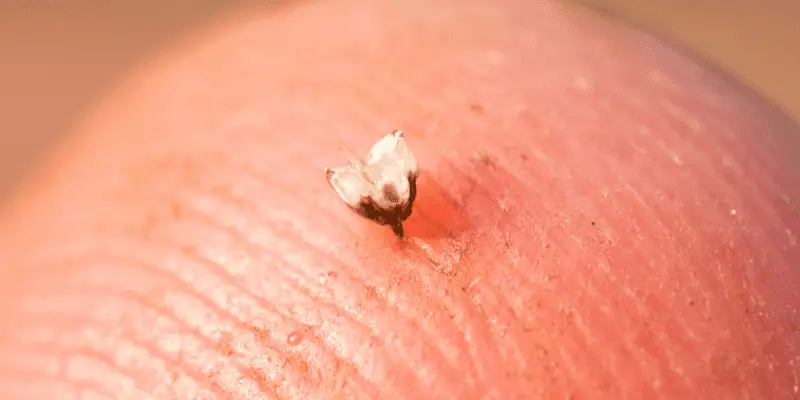
Apply Ice To The Site Of The Sting
Using a cold compress is very effective at reducing pain and inflammation. Ice is the most reliable option around the house. First, thoroughly wash the area to get rid of any residue of venom. Then-
- Place ice cubes in a bag, or you can use a bag of frozen food
- Put the ice pack or bag on the sting area
- Keep it there for 20 minutes
- Repeat until the swelling goes away
Always put something between ice and skin. Direct skin contact with ice can cause skin damage.
Apply Medicine
The majority of bee stings can be managed without medical attention, but several products can help alleviate the pain.
- Aspirin or acetaminophen can help reduce the pain.
- Antiseptic sprays or lotions help lower the risk of infection
- Antihistamine lotions can control the swelling. Creams are better than oral antihistamines as they immediately affect the sting
Oral corticosteroids may be administered for 3 to 5 days if the local reaction is severe, such as severe local edema.
Bee Sting Home Remedies
If the bee sting doesn’t lead to an allergic reaction, you can soothe the pain using home remedies. These are helpful if anyone doesn’t like to or can’t take pain medications. Here are some options:
Aloe Vera Gel
Aloe vera plants contain a natural soothing gel widely used to treat different skin conditions. You can gently rub some gel on the bee sting. The anti-inflammatory and antibacterial gel will reduce swelling and prevent the injured site from getting infected.
Aloe vera gel is available in almost every drug store.
Honey
Honey, ironically, can help.
Honey contains anti-inflammatory, antioxidant, and antibacterial agents. So, you can use it to reduce swelling, speed healing, and prevent infections.
Just stay away from more bees when you apply it, as bees are attracted to honey.
Calamine Lotion
Antihistamine creams and products such as Calamine lotion are over-the-counter solutions for skin conditions such as itchings and irritations caused by insect stings. Simply coat a thin layer of calamine lotion onto the affected area and put a one-time bandage over it.
Toothpaste
People say toothpaste is a remedy for bee stings. However, there is no substantial research to back up its efficacy.
The thought is that alkaline toothpaste helps neutralize the venom.
Epsom Salt
Epsom salts have magnesium and sulfate, which can naturally reduce swelling around the sting. Plus, the salts can help bring the stinger closer to the surface of the skin, making it easier to remove the stinger.
Create a paste or a soak for the affected area and allow the Epsom salt to work its magic.
Mud
This natural remedy is best used when no other alternatives are available.
Simply dab some dark mud over the bee sting and allow it to dry. The salt in the mud should absorb the venom and can even help bring the stinger closer to the surface for you to remove.
Yellow Mustard
Mustards that contain vinegar can be anti-inflammatory and a great way to neutralize any pain caused by a bee sting.
Yellow mustard does stain and has a pungent smell, so we like to avoid this remedy.
Tobacco
Nicotine can act as an anesthetic, which should dull the pain.
Simply wet the end of a cigarette or the tobacco leaves within it. Apply the ‘tobacco juices’ to the bee sting and after a few minutes, the pain should go down.
Things To Avoid Using When Treating A Bee Sting
Baking Soda
Some people use baking soda on the sting area as they believe baking soda can neutralize bee venom and draw out the stinger. Although this treatment has shown positive results for jellyfish stings, there is no relevant research for bee stings.
Moreover, you should avoid using baking soda as it is very alkaline. Using alkaline compounds can lead to skin damage.
Despite the lack of research, many regard baking soda as a popular and effective home remedy to treat bee stings.
Apple Cider Vinegar
Many folks claim apple cider vinegar works wonders in treating bee stings. There’s no scientific evidence to back this up. Also, as another acidic substance, it can harm your skin if not applied properly.
When To See A Doctor
You don’t need to run to the doctor unless you have a bee sting allergy or extreme cases like an anaphylactic reaction.
But sometimes, a sting can become infected. Get proper medical treatment if the affected area has pus discharge or if the pain, swelling, or redness caused by the initial sting increases.
How Much of a Threat Are Bee Stings
Cartoons and horror movies often perpetuate many myths about bee stings. Most bees aren’t aggressive unless they perceive danger. Knocking over a hive or disturbing a nest while doing yard work may rile up the bees, which will react by stinging.
Swarming bees are not like an angry gang looking for trouble. Bees swarm when their colony splits, and a group of hundreds or thousands of them and their queen search for a new home.
Before they find the best location, they may temporarily rest in a location as scout bees check out sites. Within a few days, they are usually settled. Swarms are unlikely to attack unless provoked.
Africanized or killer bees are more aggressive than honey bees. Why? In the tropical climates, they come from, there are more predators to attack colonies, so they are conditioned to respond quickly as a group to perceived threats.
However, even honey bees can be triggered by vibrations, carbon dioxide, hair, dark colors, or other bees emit an alarm pheromone that signals danger.
People may react to bees by trying to swat them away, but a bee might register this as a threat. A better tactic is to stay still, avoid flaying the arms, and hold one’s breath until the bee moves on.
